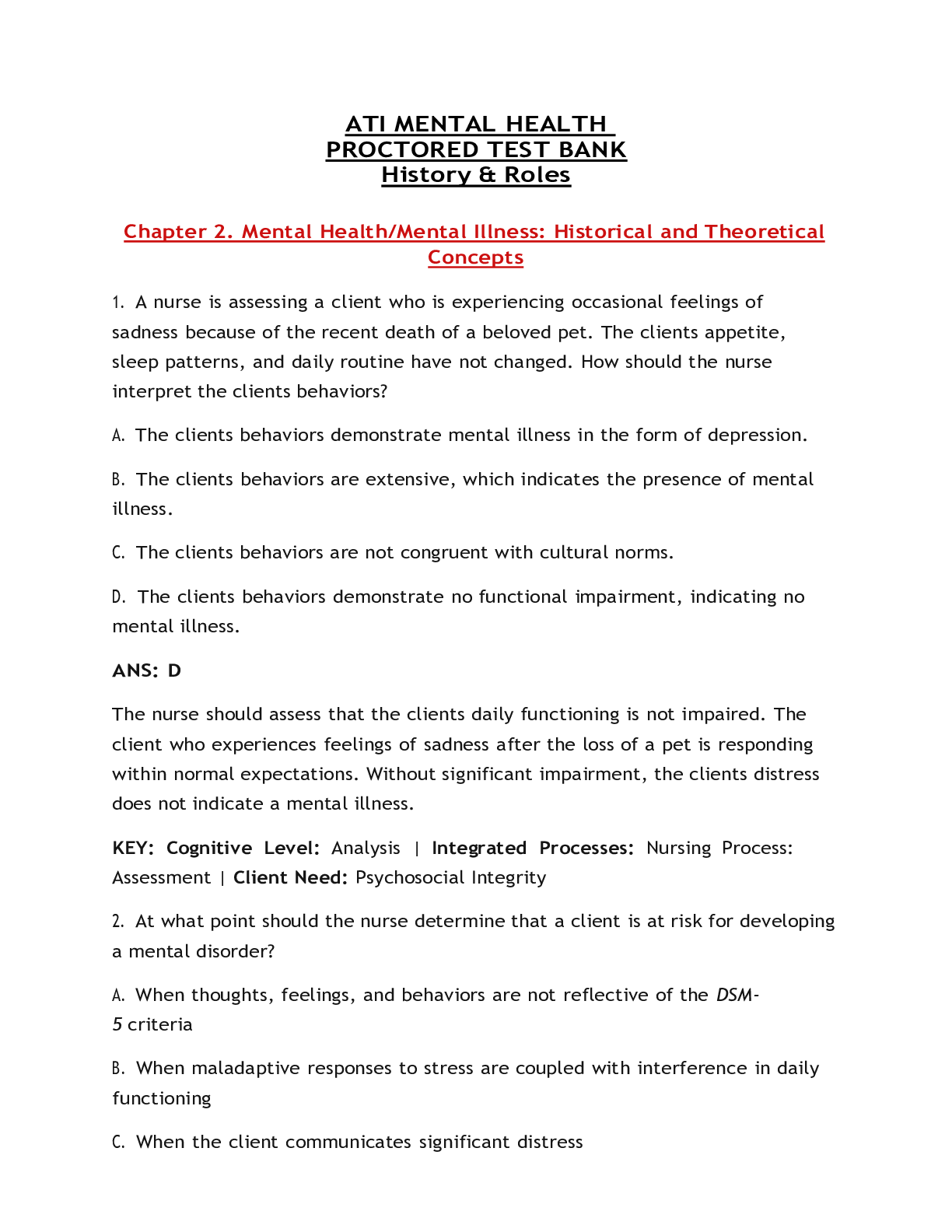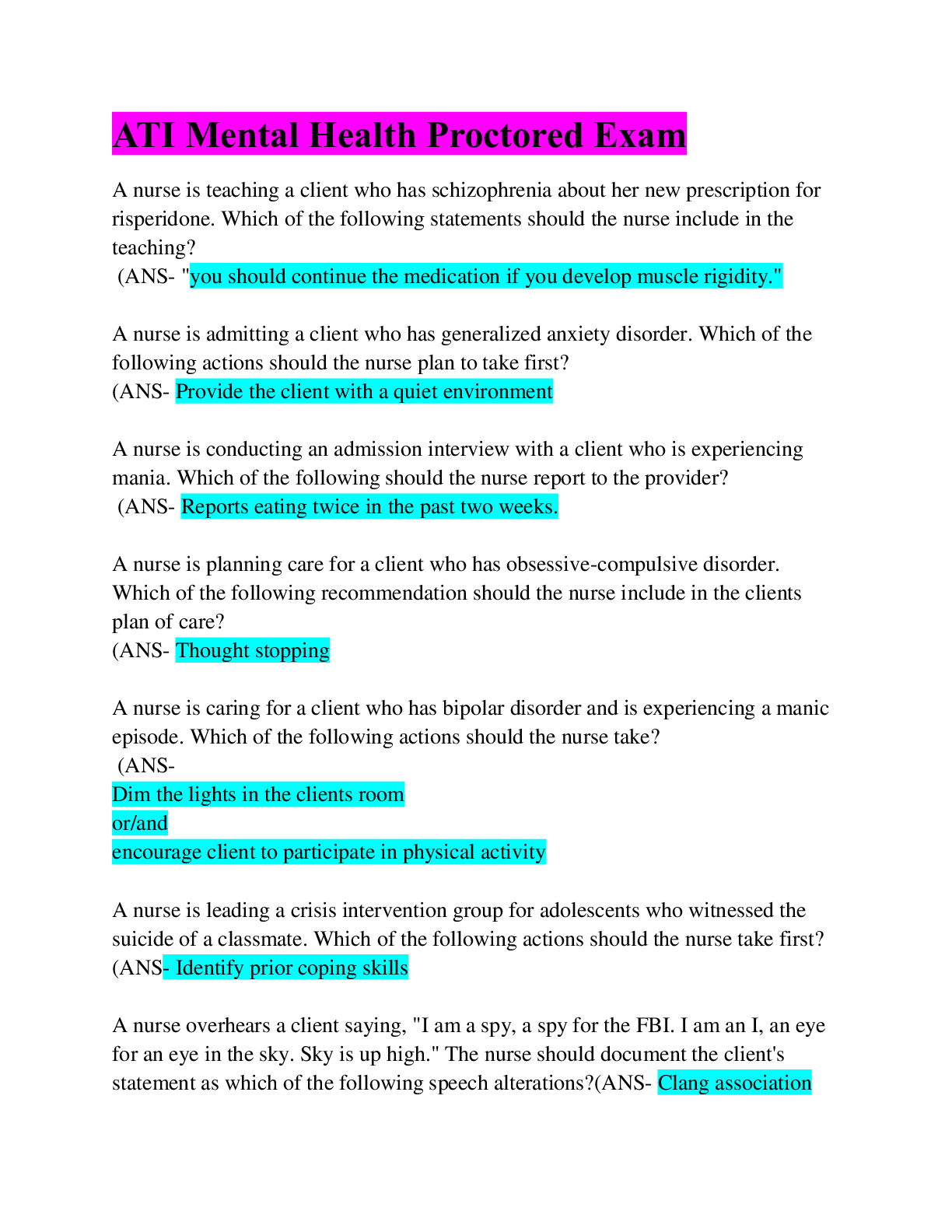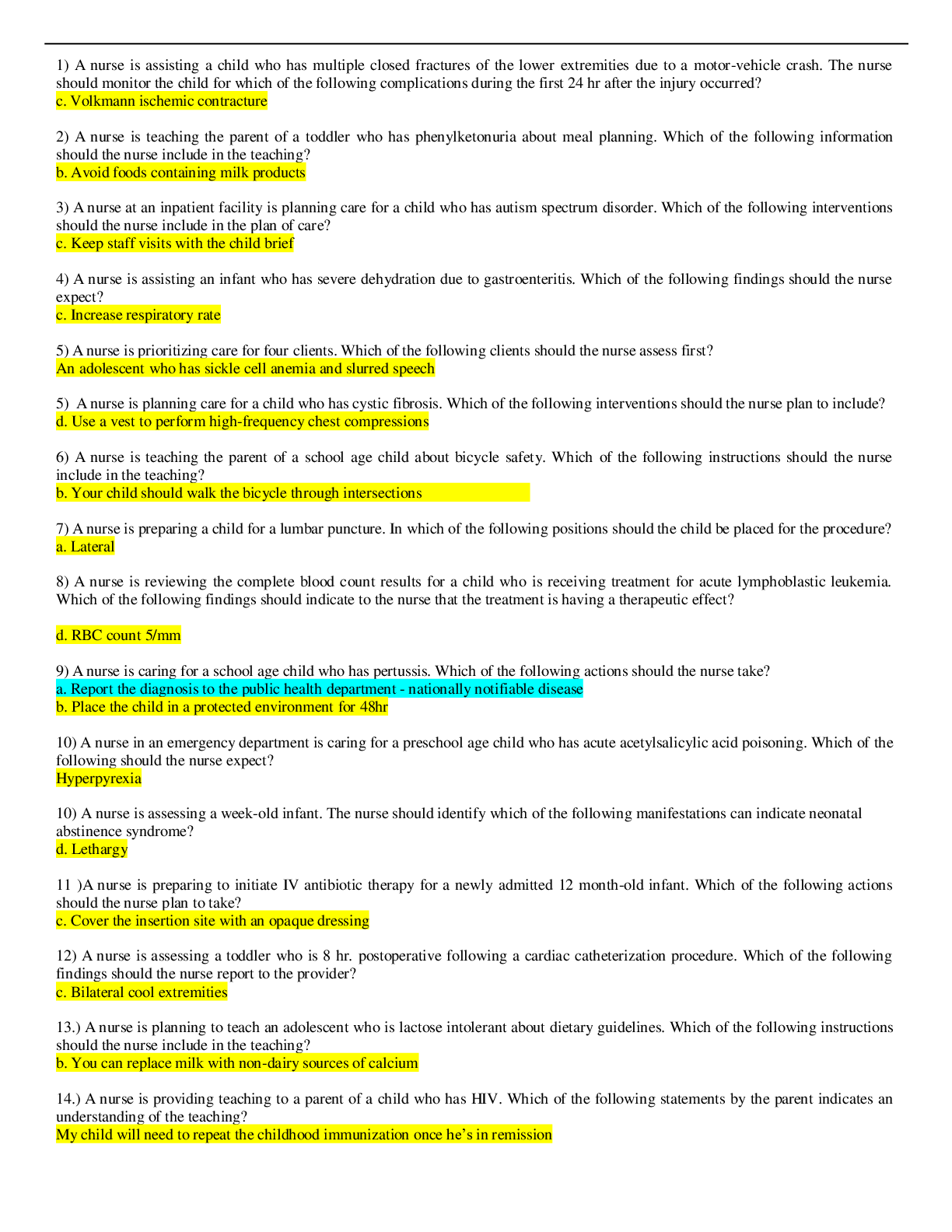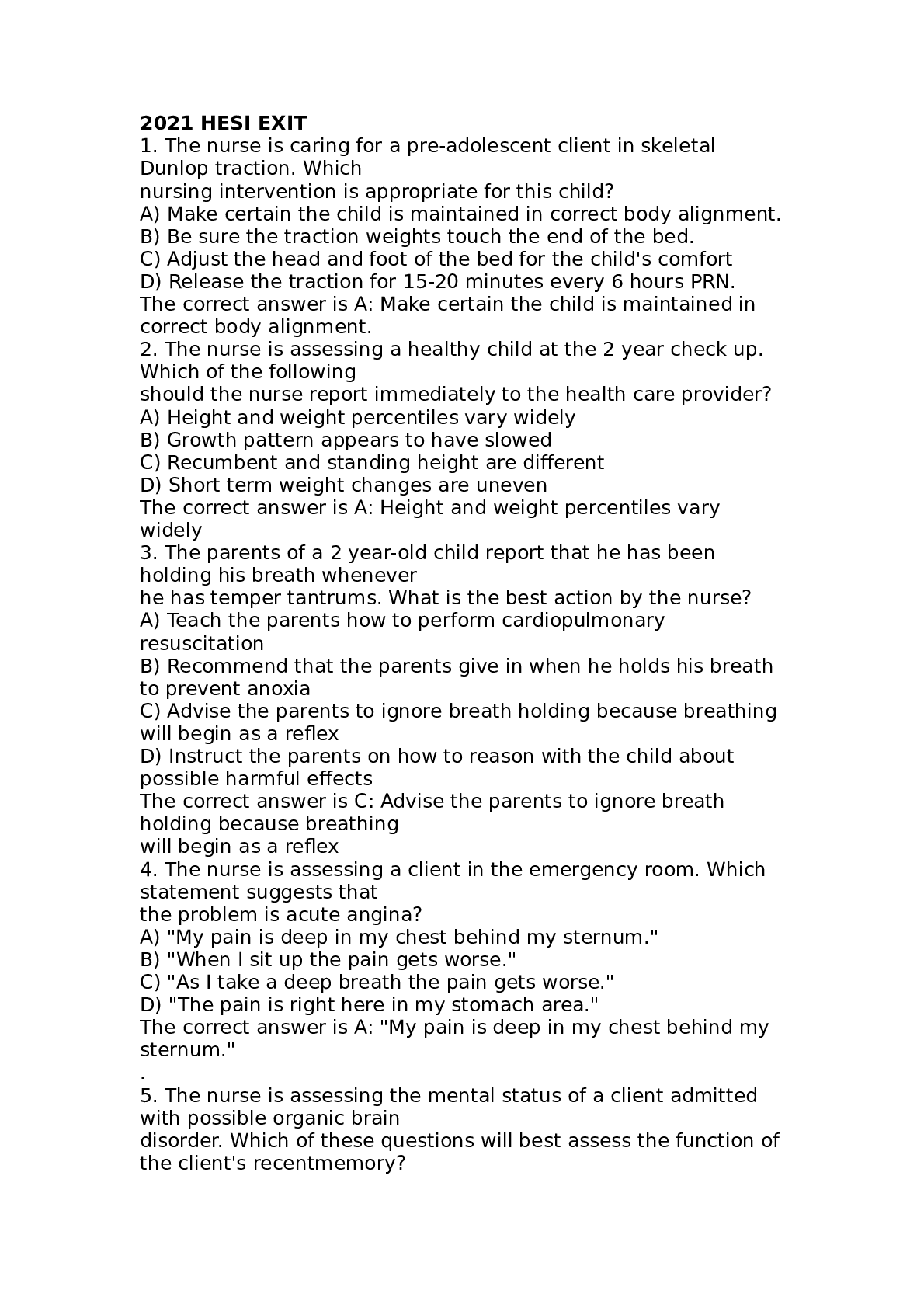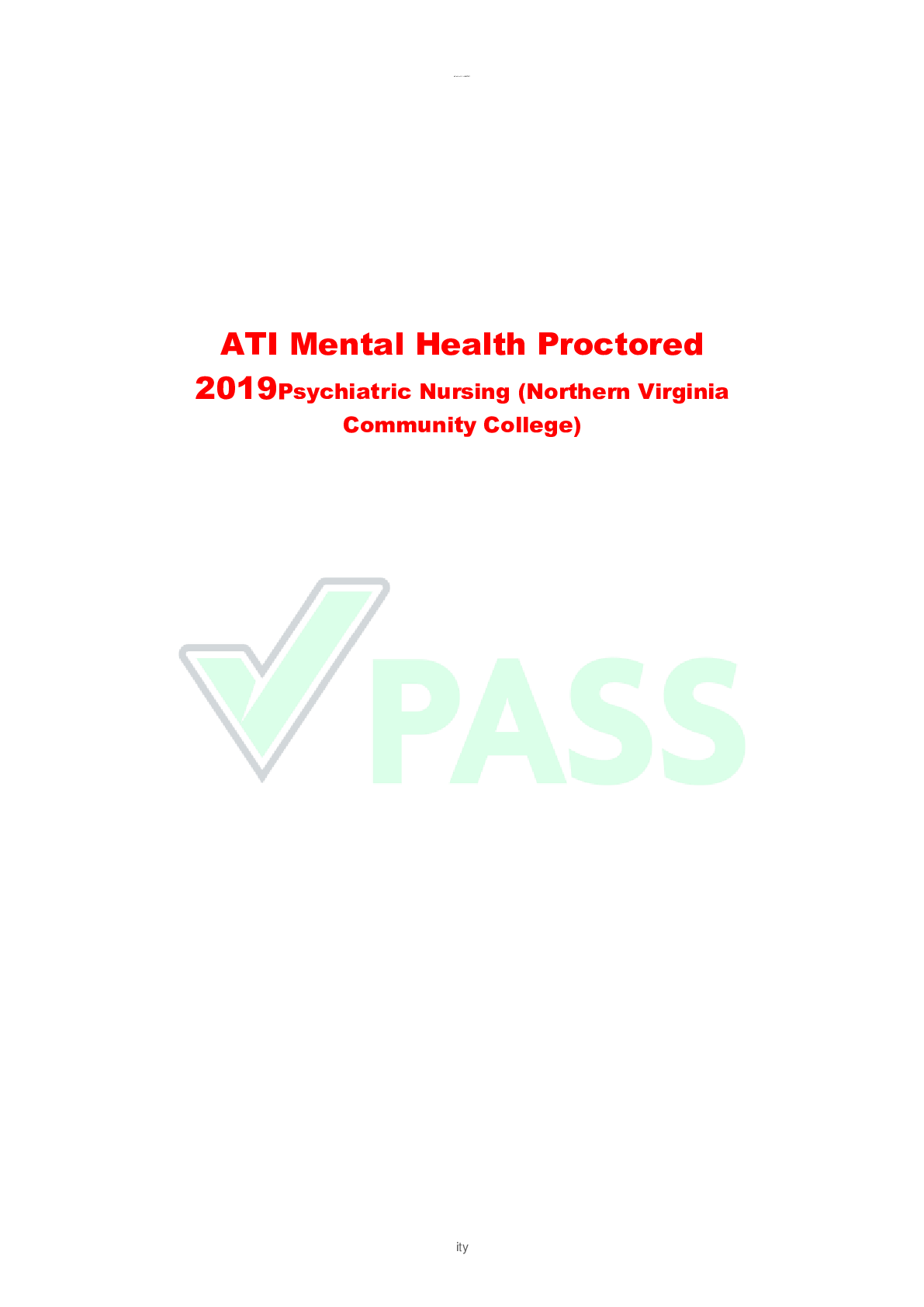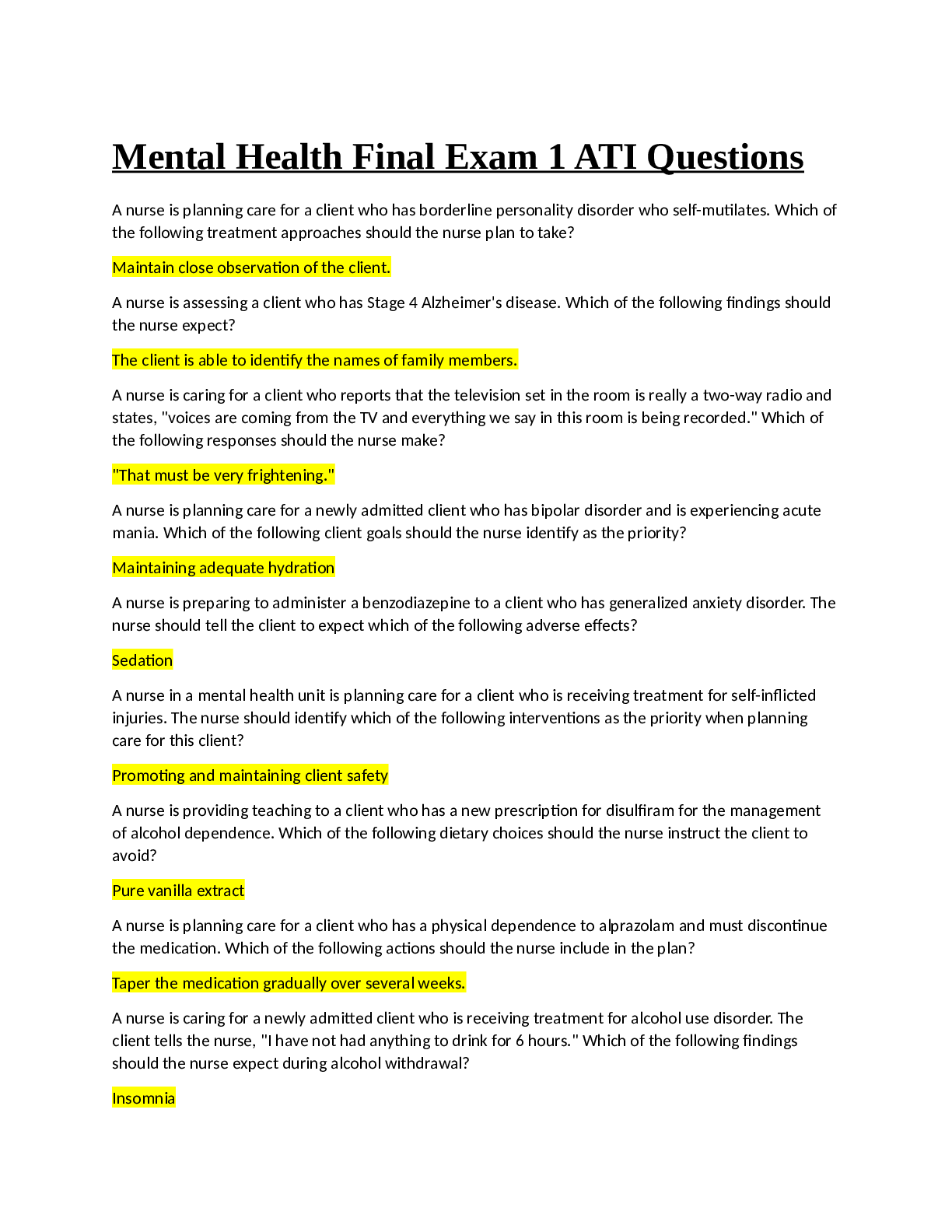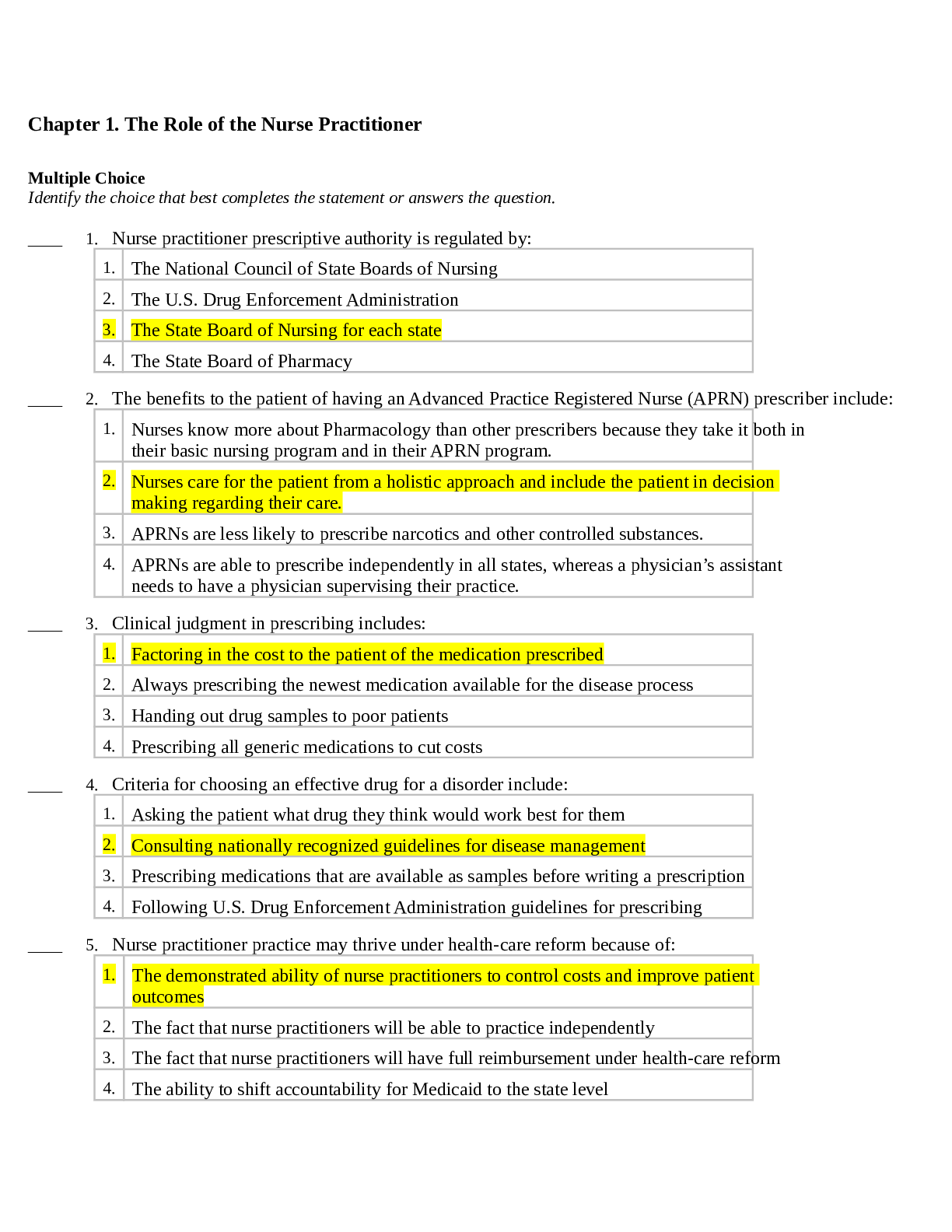*NURSING > TEST BANK > NURSING 4764 ATI Mental Health 2019 B Practice Questions And Answers/Top Score. (All)
NURSING 4764 ATI Mental Health 2019 B Practice Questions And Answers/Top Score.
Document Content and Description Below
Mental Health 2019 B Practice 1) A nurse is assessing a family’s dynamics during a counseling session. The nurse should recognize which of the following findings as an indication of a boundary issu ... e? -An adolescent family member who questions parental authority An adolescent who questions parental authority is demonstrating appropriate behavior for developmental age. -A family with three generations in the same household This scenario occurs in many households, and it is not an indication of a boundary issue. -Older children who are responsible for their younger siblings This is an example of enmeshed boundaries in which there are no distinctions between the roles of family members. -Two adults and their children from prior relationships in the same household This is an example of a blended family, and it is not an indication of a boundary issue. 2) A nurse is performing an admission assessment on a client and notices that the client appears withdrawn and fearful. To establish a trusting nurse client relationship. Which of the following actions should the nurse take first? -Inform the client that this admission is confidential. According to evidence-based practice, the nurse should first inform the client about confidentiality during the orientation phase of the nurse-client relationship. -Introduce the client to other clients in the day room. The nurse should introduce the client to other clients in the day room to help the client interact with others during the working phase of the nurse-client relationship. However, evidence-based practice indicates that the nurse should take a different action first. -Assist the client in facilitating behavioral change. The nurse should assist the client with behavioral change during the working phase of the nurse-client relationship. However, evidence-based practice indicates that the nurse should take a different action first. -Determine coping strategies that the client has used in the past. The nurse should determine what coping strategies the client used in the past during the working phase of the nurse-client relationship. However, evidence-based practice indicates that the nurse should take a different action first. 3) A nurse is performing a cognitive assessment to distinguish delirium from dementia in a client whose family reports episodes of confusion. Which of the following assessment findings supports the nurse’s suspicion of delirium? -Slow onset Delirium has an acute onset. Dementia is a slow, progressive decline. -Aphasia Aphasia is a manifestation of dementia. -Confabulation Confabulation is a manifestation of dementia. -Easily distracted Extreme distractibility is a hallmark manifestation of delirium. 4) A nurse is caring for an older adult client who is experiencing delirium. Which of the following interventions should the nurse include in the client’s plan of care? -Offer the client various choices for meal selection. The nurse should provide a client who has delirium with a plan of care that decreases agitation and anxiety by limiting the choices the client is asked to make. -Assign different nursing personnel for each shift. The nurse should provide a client who has delirium with a plan of care that decreases agitation and anxiety by providing consistent nursing personnel. -Permit the client to perform daily rituals to decrease anxiety. The nurse should provide a client who has delirium with a plan of care that decreases agitation and anxiety by permitting the client to perform daily rituals. -Maintain an environment that has low lighting. The nurse should provide a client who has delirium with a plan of care that decreases agitation and anxiety by providing a well-lit environment. 5) A nurse is planning care for a newly admitted client who has bipolar disorder and is experiencing mania. Which of the following interventions should the nurse include in the plan of care? -Encourage the client to participate in group therapy. The nurse should maintain a low-stimuli environment for a client who is experiencing mania. The nurse should dim the lights, decrease noise, and limit the number of people the client is around. -Instruct the client to avoid napping during the day. The nurse should encourage the client to take frequent rest periods throughout the day. Clients experiencing mania are at risk of exhaustion that can be life threatening. -Offer the client high-calorie finger foods frequently. The nurse should frequently offer the client high-calorie foods that can be eaten while the client is on the go. Clients experiencing mania might be unable to sit down for meals and can experience weight loss and dehydration. -Decrease the client's daily fiber intake. The nurse should encourage the client to eat foods and snacks that are high in fiber. Clients experiencing mania can experience dehydration and nutritional deficiencies from decreased intake, which can lead to constipation. 6) A nurse is teaching the partner of a client who has bipolar disorder how to identify manifestations of acute mania. Which of the following findings should the client's partner report to the provider? -Obsessive attention to detail During the manic phase of bipolar disorder, a client's behavior becomes disorganized and chaotic, which renders the client unable to focus on detail. -Inability to sleep During acute mania, the client is extremely active and does not sleep, which can lead to exhaustion. Therefore, the nurse should instruct the partner to report this finding. -Reports of fatigue Although the client who is experiencing acute mania might eventually become exhausted, there is a characteristic unawareness of fatigue during this phase. -Isolation from others Clients who are in the manic phase of bipolar disorder often talk and joke incessantly and are highly interactive. 7) A nurse is caring for a client who is experiencing a panic attack. Which of the following actions should the nurse take? -Orient the client to person, place, and time. A client who is experiencing a panic attack is generally not disoriented. -Assist the client with deep-breathing exercises. Relaxation techniques, such as deep, abdominal breathing exercises, help defuse manifestations of anxiety. -Calm the client by using therapeutic touch. Therapeutic touch is not intended to de-escalate panic in a client who is anxious. -Have the client sit alone in a quiet room. It is recommended that the nurse stay with a client who is experiencing panic anxiety to ensure the client's safety. 8) A nurse is talking with a group of parents who have recently experienced the death of a child. Which of the following actions should the nurse take? -Encourage the parents to avoid discussing the death with their other children to protect their feelings. Siblings also experience feelings of intense grief and need to know it is acceptable for the family to grieve together. -Recommend each parent grieve in private to avoid hindering each other's healing. Although parents tend to grieve differently, it is important they share their grief and communicate their needs to decrease the likelihood of marital upset. -Suggest forming a weekly support group for parents who have experienced the death of a child. Support groups are a positive resource in the process of recovery for parents following the death of a child. -Advise the parents to begin counseling if they are still grieving in a few months. The grief process varies for each individual. Setting an expected period for grief places the parents at risk for further problems if they feel they have not completed the grieving process in an acceptable amount of time. 9) A nurse is teaching a group of newly licensed nurses about the use of mechanical restraints. Which of the following information should the nurse include in the teaching?10) -Complete documentation about the client's status every hour while they are in restraints. The nurse should document the client's status, including behavior and vital signs, and address the client's physical and safety needs every 15 min. -Maintain the client in restraints for a minimum of 4 hr. Restraints should be removed as soon as the client is able to follow instructions, control their behavior, and is no longer at risk for injuring themselves or others. The maximum amount of time an adult client should remain in restraints is 4 hr. -Apply restraints when other means of managing the client's behavior have failed. According to the Patient Self-Determination Act, clients have a right to be free from restraints or seclusion unless the safety of the client or others is at risk. De-escalation methods for controlling behavior should be attempted prior to initiating restraints. -Request that the provider assess the client within 8 hr of the application of restraints. The use of mechanical restraints requires a provider's prescription. In emergent cases, the prescription can be obtained after restraints have been applied. However, the provider must evaluate the client within 1 hr of the initiation of restraints 10) A nurse is assessing a client who is experiencing opioid withdrawal. Which of the following manifestations should the nurse expect? -Sedation The nurse should expect the client experiencing opioid withdrawal to have insomnia. -Rhinorrhea The nurse should expect the client who is experiencing opioid withdrawal to have rhinorrhea and flu-like manifestations such as yawning, sneezing, and abdominal pain. -Bradycardia The nurse should expect the client experiencing opioid withdrawal to have tachycardia. -Hypothermia The nurse should expect the client experiencing opioid withdrawal to have hyperthermia. 11) A nurse is facilitating a community meeting for acute care clients. One client is constantly talking and using the majority of the group’s time. Which of the following interventions should the nurse implement? -Tell the client to talk less or risk being removed from the meeting. Threatening the client is not a therapeutic intervention. -Ask group members to discuss their feelings about this client's monopolizing behavior. This intervention will validate other members' feelings toward the client who is dominating the meeting. It also should encourage group problem-solving. -End the group meeting and take the client aside to discuss the disruptive behavior. This intervention is punitive to all members of the group, and it does not address the problem within the group setting. -Focus on other group members and ignore the client who is doing all the talking. Ignoring the client does not address the behavior and is unlikely to solve the problem. 12) A nurse is assessing a client who has bulimia nervosa. The nurse should expect which of the following findings? -Amenorrhea A client who has anorexia nervosa is more likely to have amenorrhea resulting from low body weight. -Lanugo A client who has anorexia nervosa is more likely to have lanugo resulting from extreme malnutrition. -Cold extremities A client who has anorexia nervosa is more likely to have cold extremities from extreme malnutrition. -Tooth erosion A client who has bulimia nervosa is likely to have dental caries and tooth erosion caused by frequent exposure to gastric acid from vomiting. 13) A nurse in a community health center is working with a group of clients who have post traumatic stress disorder. Which of the following interventions should the nurse include to reduce anxiety among the group’s members? -Response prevention Response prevention is used in the treatment of compulsive behavior. -Guided imagery Guided imagery involves assisting the client to imagine a restful and safe place. This method is effective in reducing anxiety in clients who have post-traumatic stress disorder. -Aversion therapy Aversion therapy is a negative feedback method used to treat alcohol use disorder, violent behavior, and self-mutilation. -Light therapy Light therapy is used in the treatment of seasonal affective disorder, a type of depression. 14) A nurse is preparing to discharge to home an older adult client who attempted suicide. The client lives alone and has difficulty performing ADLs. Which of the following referrals should the nurse initiate? Select all that apply -Occupational therapy is correct. An occupational therapist can assist the client to perform ADLs. -Meal delivery services is correct. Meal delivery services are necessary due to the client's difficulty performing ADLs. -Physical therapy is correct. A physical therapist can assess the client's mobility needs and assist with ADLs. -Home health services is correct. Home health services provide a nursing assessment of the client's physical and mental status, as well as assistance with ADLs. -Speech-language pathologist There is no indication that the client needs a referral for a speech-language pathologist. This referral would be indicated if the client had difficulty swallowing. 15) A nurse at a provider’s office is interviewing an older adult client. Which of the following actions should the nurse plan to take? Click on the exhibit button -Use a screening tool to evaluate the client for depression. Depression can be underdiagnosed among older adult clients. The nurse should identify several risk factors for depression from the client's data, including having Alzheimer's disease, anxiety, and the loss of a loved one. Manifestations of depression can also be nonspecific for older adult clients and can include weight loss, decreased energy levels, and difficulty sleeping. -Ask the provider to decrease the dosage of the client's blood pressure medication. The client's blood pressure is within the expected reference range; the nurse should identify a systolic blood pressure of less than 90 mm Hg as hypotension. -Instruct the client to decrease intake of vitamin B12. After age 50, the body's ability to absorb vitamins can decrease. Although the older adult client takes a multivitamin daily, the nurse should instruct the client to ensure adequate intake of vitamin B12 through fortified foods, such as whole-grain products. -Suggest the client go for a brisk walk 20 min just before bedtime. Exercise can help promote sleep; however, the nurse should instruct the client not to exercise just prior to bedtime because this might worsen insomnia. 16) A nurse is planning care for a client who has made repeated physical threats toward others on the unit. Although the client does not want to leave the unit, the nurse request the provider to transfer the client to a unit that is equipped to manage violent behavior. Which of the following ethical principles should the nurse apply in this situation? -Nonmaleficence It is the responsibility of the nurse to do no harm to clients. The nurse is applying the ethical principle of nonmaleficence by requesting to transfer this client to a unit better able to manage their behavior and thereby prevent injury to others on the unit. -Veracity The nurse applies the ethical principle of veracity when being truthful with clients and others. -Justice The nurse applies the ethical principle of justice when treating all individuals equally and fairly. -Autonomy The nurse applies the ethical principle of autonomy by respecting a client's right to make independent choices. 17) A nurse is preparing to participate in an interdisciplinary conference for a client who has bipolar disorder. Which of the following behaviors is the priority for the nurse to report to the treatment team? -Calling family members The nurse should report that the client is calling family members to indicate that the client has a support system. However, another behavior is the priority. -Spending time alone The nurse should report that the client is spending time alone to indicate the client is withdrawn from others. However, another behavior is the priority. -Giving away possessions Giving away possessions indicates that this client is at greatest risk for suicide. Therefore, this is the priority finding for the nurse to report to the treatment team. -Excessive crying The nurse should report that the client is crying excessively to indicate the client is showing signs of depression. However, another behavior is the priority. 18) A nurse is assessing a client for risk factors for the development of depression. The nurse should identify that which of the following factors places the client at an increased risk for depression? -The client is married. The nurse should identify that clients who are single, not clients who are married, are at an increased risk for the development of depression. -The client recently received a promotion at work. The nurse should identify that the presence of a negative life event, rather than a positive one, is a risk factor for the development of depression. -The client has COPD. The nurse should identify that clients who have a chronic medical illness are at an increased risk for the development of depression. -The client is a male. The nurse should identify that clients who are female, not male, are at an increased risk for the development of depression. 19) A nurse is counseling an adolescent who has anorexia nervosa and reports excessive laxative use and a fear of gaining weight. The client states I am so fat I can’t even stand to look at myself. Which of the following therapeutic responses demonstrates the nurses use of summarizing? -"You've discussed several concerns about your weight. Let's go back and talk about your belief that you are fat." The nurse is using the therapeutic technique of focusing in this statement. -"You're saying that you think you are fat and are using laxatives because you are afraid of gaining weight." The nurse is using the therapeutic technique of summarizing to review the key points of the discussion. -"You don't want to look at yourself because you think you are fat." The nurse is using the therapeutic technique of restating in this statement. -"You and I can work together to overcome your fears of gaining weight." The nurse is using the therapeutic technique of suggesting collaboration in this statement. 20) A nurse is caring for four clients in an emergency department. The nurse should identify that which of the following clients can give informed consent? -A 17-year-old client who lives with friends Individuals younger than 18 years of age can only provide informed consent if they are married, pregnant, parents, or emancipated. -A 50-year-old client who has a blood alcohol level of 80 mg/dL A client who is intoxicated cannot legally give informed consent. -A 35-year-old client who has major depressive disorder A client who has major depressive disorder is capable of making health care decisions unless the client is determined to be legally incompetent. -A 65-year-old client who just received a dose of morphine A client who has just received morphine, an opioid analgesic, is functionally incompetent due to the medication's effect on the CNS. 21) A nurse in a community health center is teaching families of clients who have post traumatic stress disorder PTSD about expected clinical manifestations. Which of the following manifestations should the nurse include? -Repeatedly talks about the traumatic incident The nurse should identify avoidance of discussing the traumatic event as an expected manifestation of PTSD. -Sleeps excessively The nurse should identify difficulty sleeping and hypervigilance as expected manifestations of PTSD. -Experiences feelings of isolation The nurse should expect clients who have PTSD to feel estranged and detached from others. -Uses repetitive speech The nurse should identify that verbal aggression is a manifestation of PTSD; however, repetitive speech is not. 22) A nurse is assisting a client who has a terminal illness adjust to progressive loss of independence. Which of the following statements by the client indicates acceptance of her illness? -"I am going to order a wheelchair for when I'm unable to walk." The client is recognizing the reality of continued loss of independence and is anticipating the need for assistive devices, which indicates the behavioral response of acceptance. -"I am going to stop paying my bills since I won't be around much longer." The client is verbalizing hopelessness and demonstrating the grieving stage of depression. This does not indicate acceptance. -"I wish you would go take care of somebody who actually needs you." The client is expressing anger, which is a behavioral response to grief. This does not indicate acceptance. -"I am sure I'm going to be able to continue to care for myself without help." The client is expressing denial, which is a behavioral response to grief. This does not indicate acceptance. 23) A nurse observes a client on a mental health unit pushing on the locked unit door. Which of the following statements should the nurse make? -"It appears as though you would like to open the door." This statement is an example of the therapeutic technique of making observations. This technique encourages the client to notice the behavior so that they can describe thoughts and feelings related to that behavior. -"You will feel more comfortable after you've been here for a while." This statement is an example of nontherapeutic communication. It is falsely reassuring the client that everything will be fine. This type of communication minimizes the client's concerns and offers no constructive interventions. -"It is okay to not want to be here." This statement is an example of nontherapeutic communication. It assumes an understanding of the client's feelings and offers no constructive interventions. -"You really shouldn't be pushing on the door." This statement is an example of nontherapeutic communication. Disapproval of the client's actions can make the client defensive and offers no constructive interventions. 24) A nurse is planning prevention strategies for partner violence in the community. Which of the following strategies should the nurse include as a method of secondary prevention? -Provide teaching about the use of positive coping mechanisms. This is an example of primary prevention. Positive coping mechanisms help clients and their partners cope with stress and help to prevent the incidences of partner violence in the community. -Establish screening programs to identify at-risk clients. This is an example of secondary prevention. By establishing screening programs, the nurse can identify individuals who are at risk for partner violence in the community and can take the necessary steps to address individual client needs. -Refer survivors of intimate partner abuse to a legal advocacy program. This is an example of tertiary prevention. Tertiary prevention takes place after partner violence has occurred and facilitates support and healing for the client. -Organize rehabilitation therapy for clients who have experienced intimate partner abuse. This is an example of tertiary prevention. Tertiary prevention takes place after partner violence has occurred and facilitates support and rehabilitation for the client. 25) A nurse is admitting a client who has major depressive disorder in a new prescription for Tranylcypromine.Which of the following over the counter medications that the client reports taking should alert the nurse to a potential adverse reaction?. -Lansoprazole Lansoprazole does not interact adversely with tranylcypromine. -Naproxen Naproxen does not interact adversely with tranylcypromine. -Magnesium hydroxide Magnesium hydroxide does not interact adversely with tranylcypromine. -Phenylephrine Clients who are taking tranylcypromine, an MAOI antidepressant, should not take phenylephrine and other over-the-counter medications for sinus congestion, colds, or allergies due to their actions on the sympathetic nervous system, which can result in severe hypertension. 26) A nurse is planning discharge teaching for a client who has severe schizoaffective disorder. The nurse should identify that which of the following treatment options can offer interdisciplinary services for the client at home? A nurse is preparing to administer DIAZEP a.m. 7.5 mg IV bolus to a client for alcohol withdrawal. Available is DIAZEP a.m. injection -Community mental health center A community health center can provide a variety of services to clients including education, group therapy, and medication administration. However, a community health center does not offer services at the client's home. -Mental health day program Day programs offer services for clients who need supervision or assistance throughout the daytime hours. However, mental health day programs do not offer services at the client's home. -Partial hospitalization program A partial hospitalization program provides intense short-term treatments for clients during the day. However, a partial hospitalization program does not offer services at the client's home. -Assertive community treatment Assertive community treatment provides comprehensive, community-based services to clients who have severe mental illness based upon individualized needs. Services are available in any setting, including the client's home, 24 hr per day and provide crisis intervention, medication services, and advocacy. [Show More]
Last updated: 1 year ago
Preview 1 out of 14 pages
Instant download
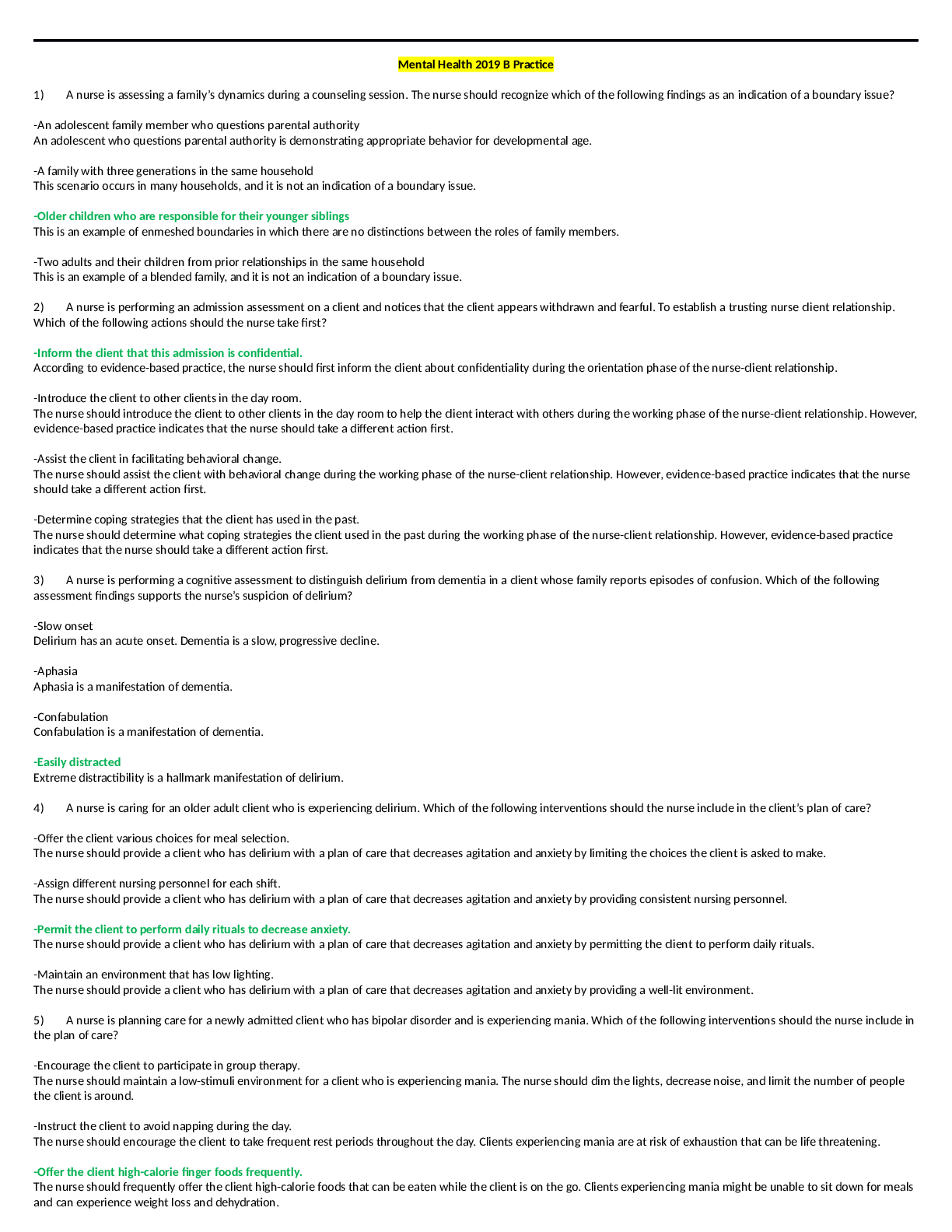
Instant download
Reviews( 0 )
Document information
Connected school, study & course
About the document
Uploaded On
Feb 25, 2022
Number of pages
14
Written in
Additional information
This document has been written for:
Uploaded
Feb 25, 2022
Downloads
0
Views
60



.png)

.png)
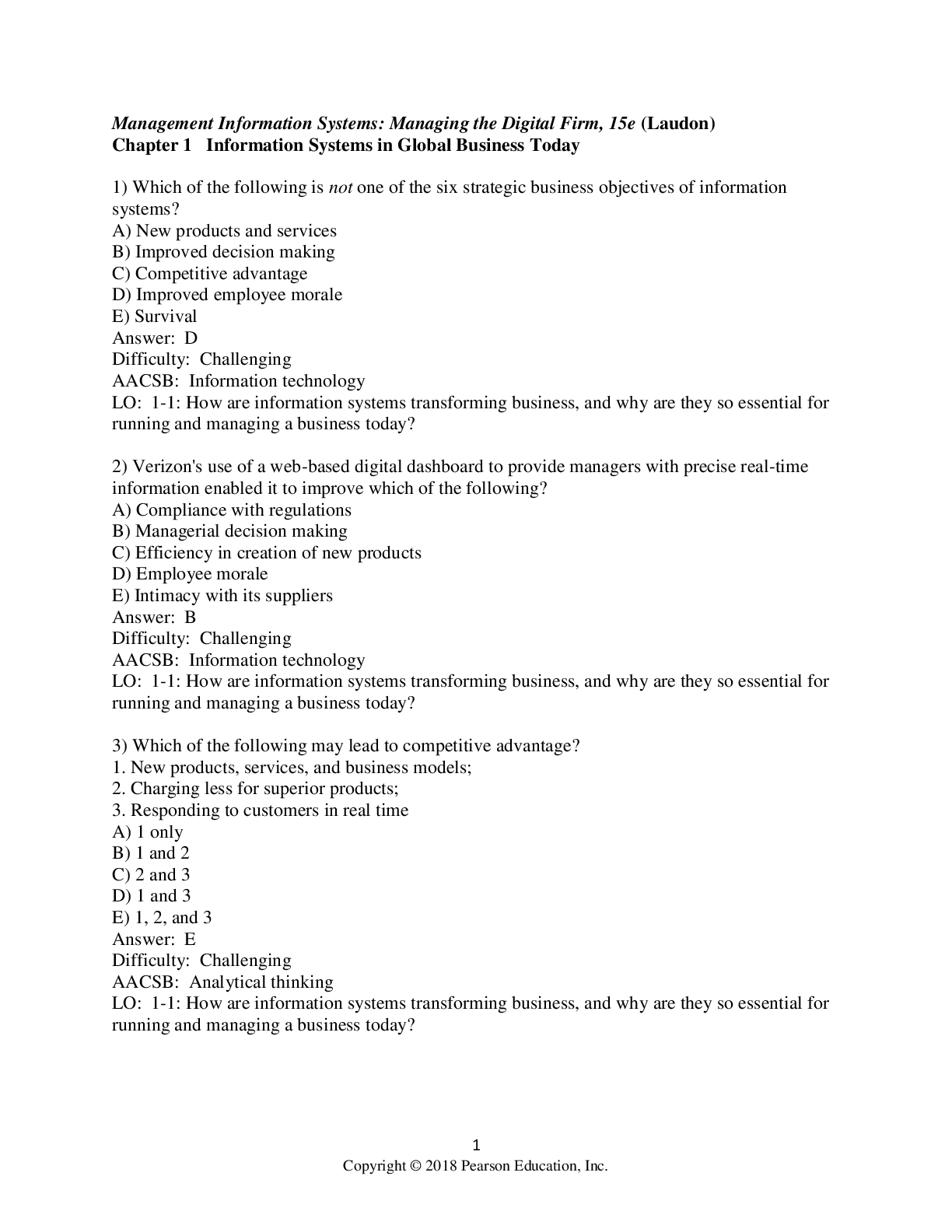
.png)

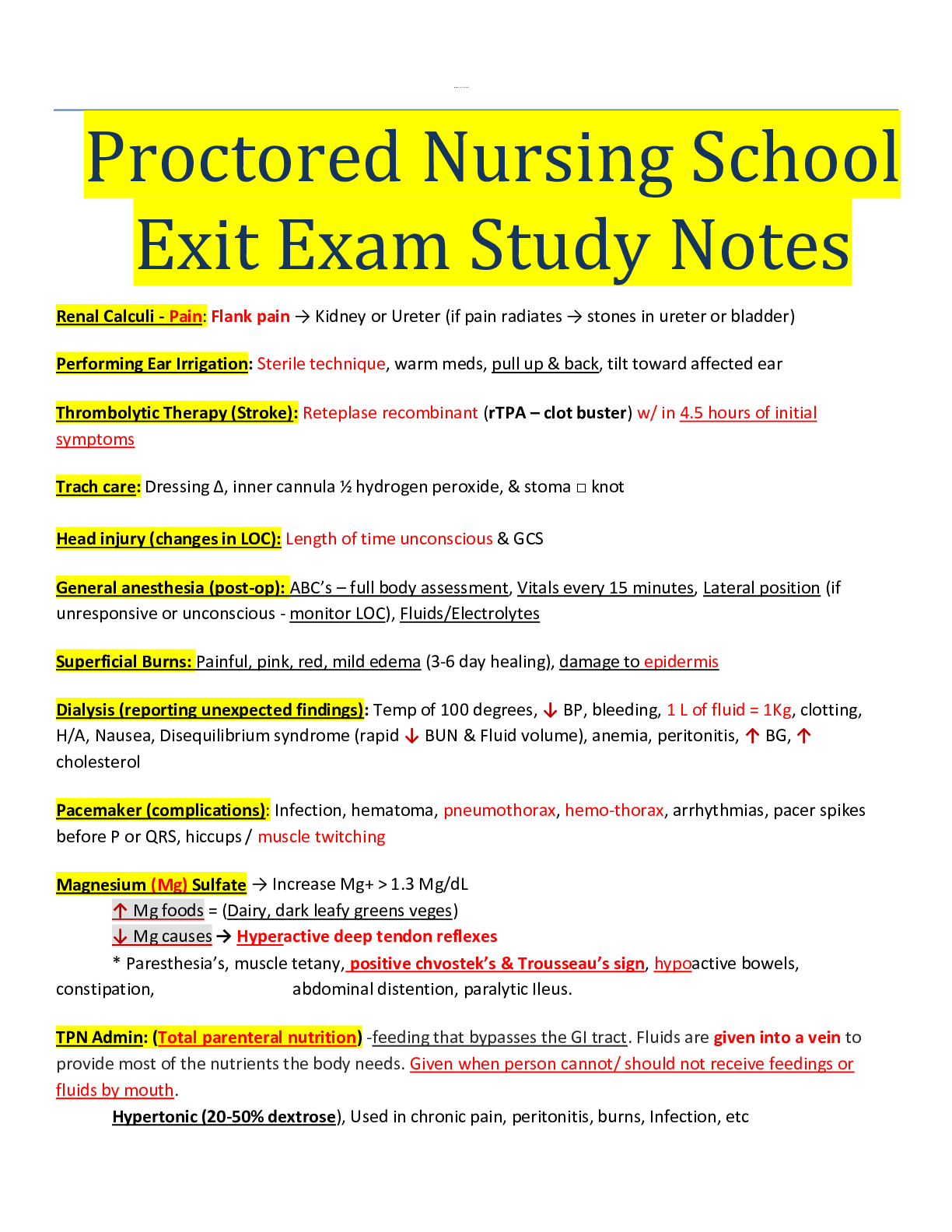
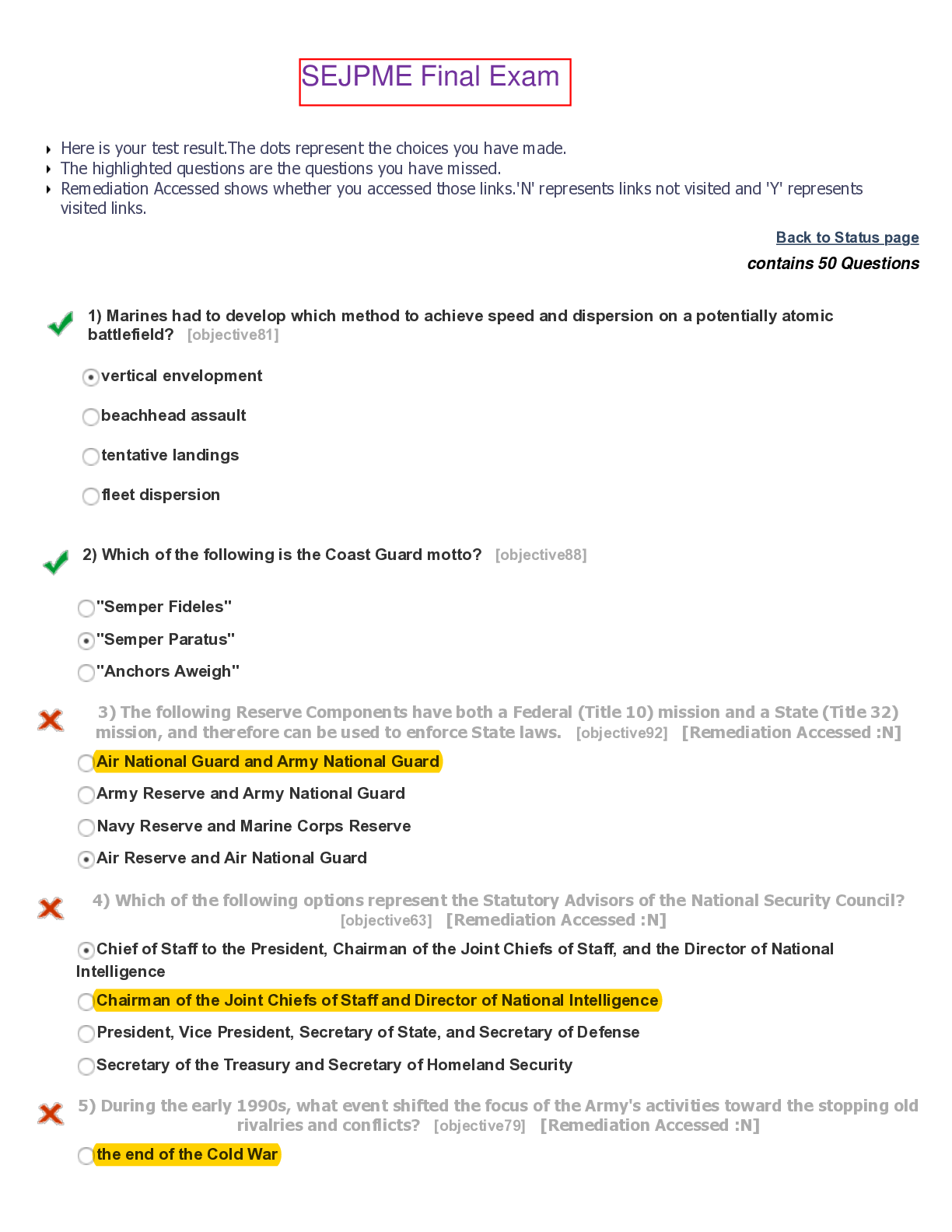

.png)

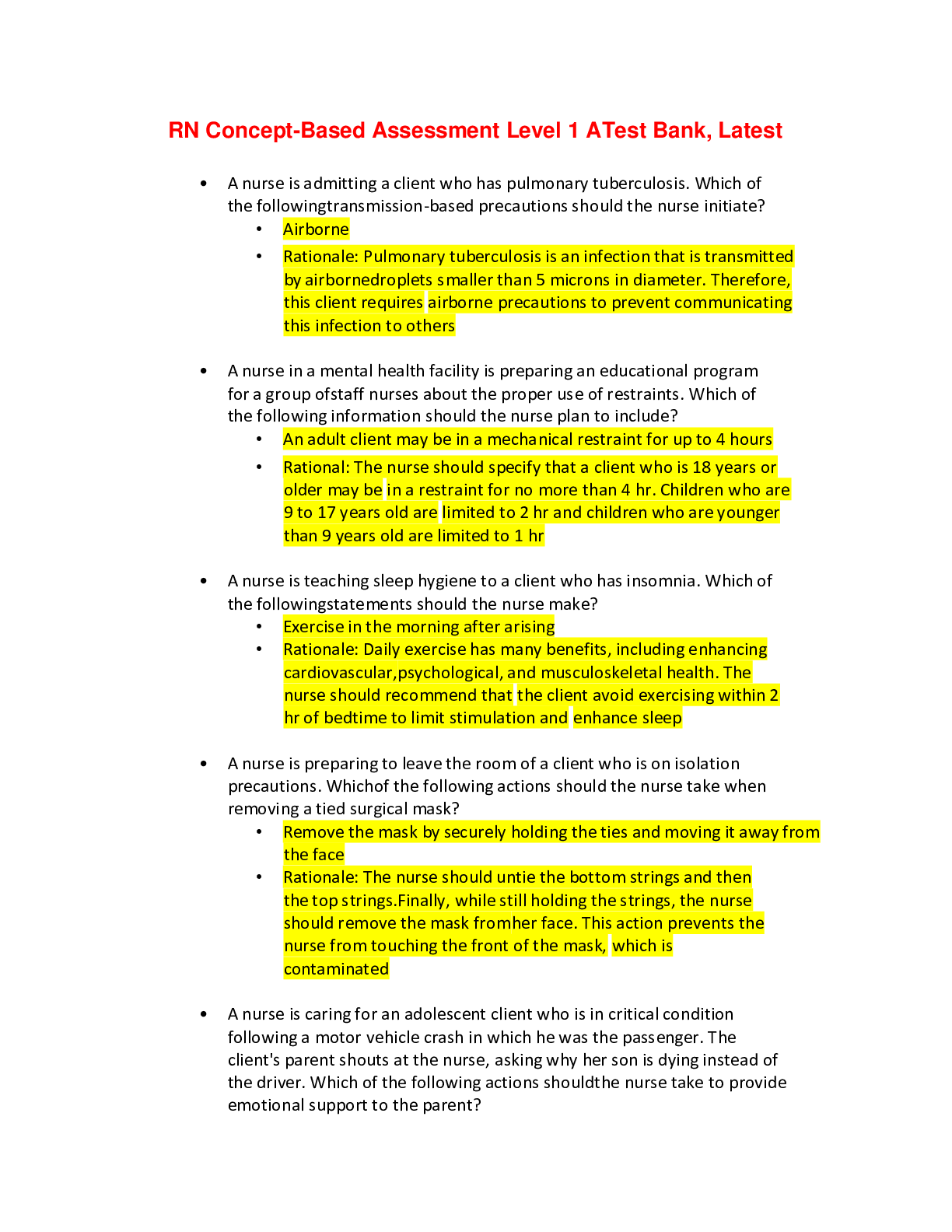
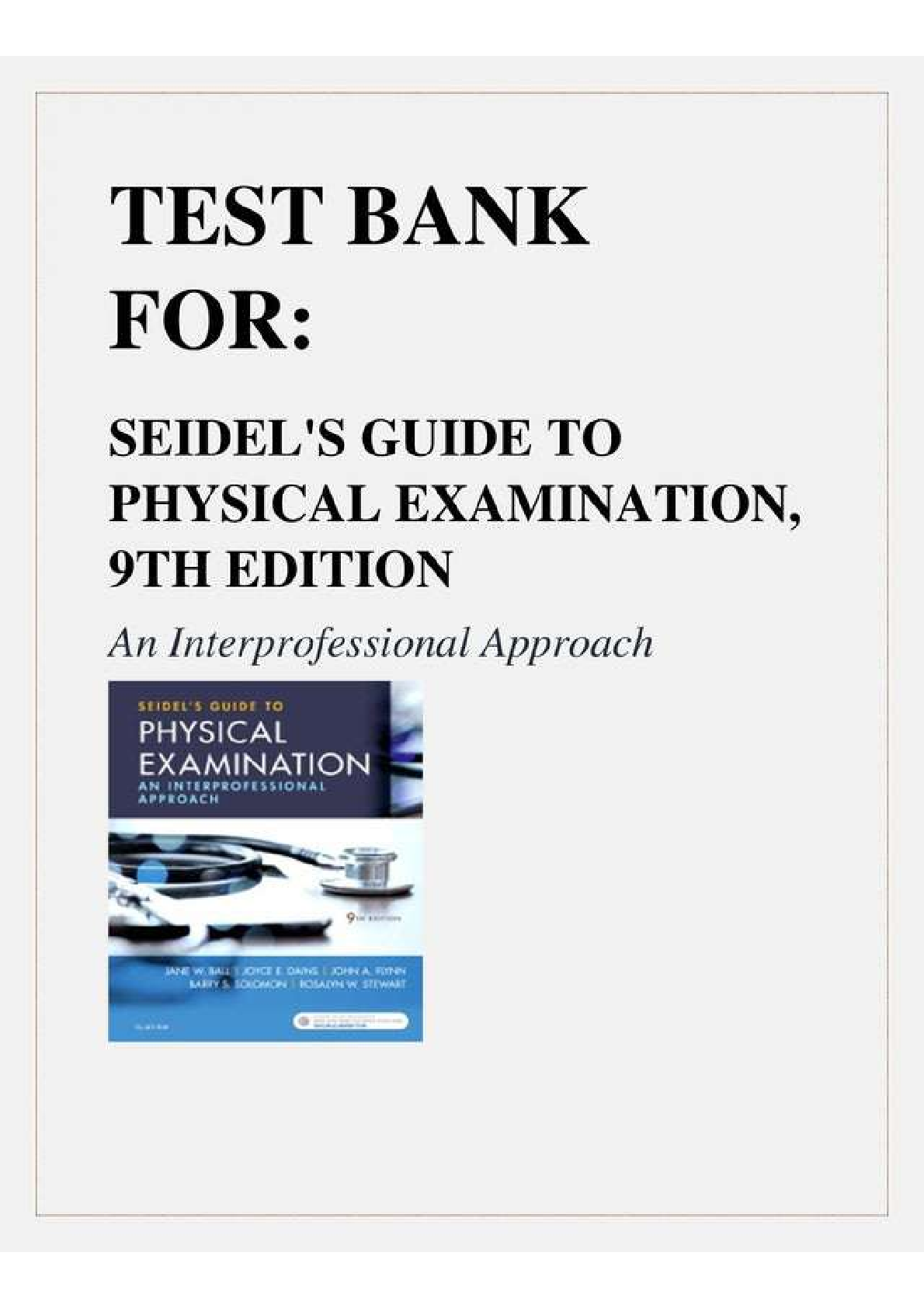

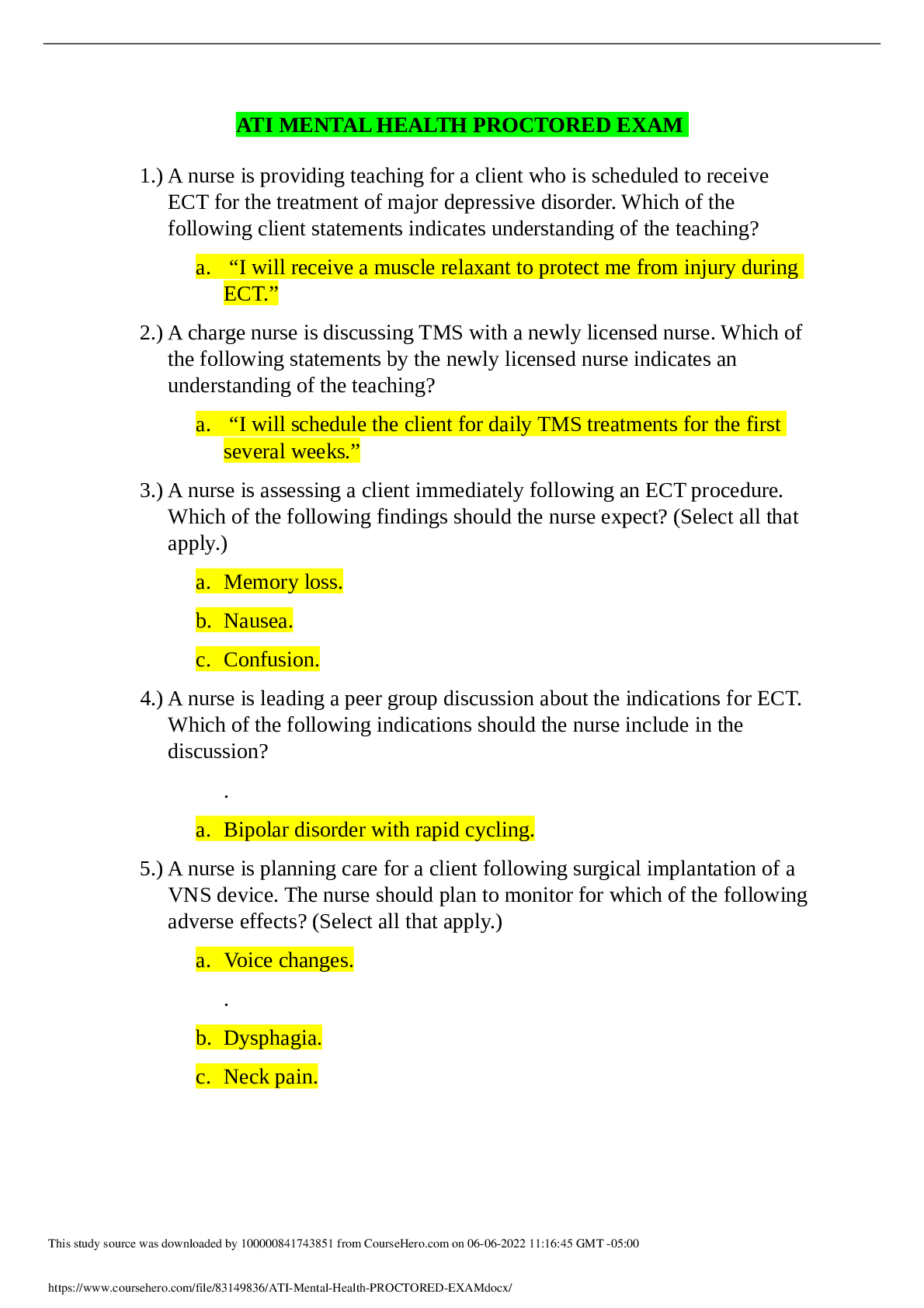

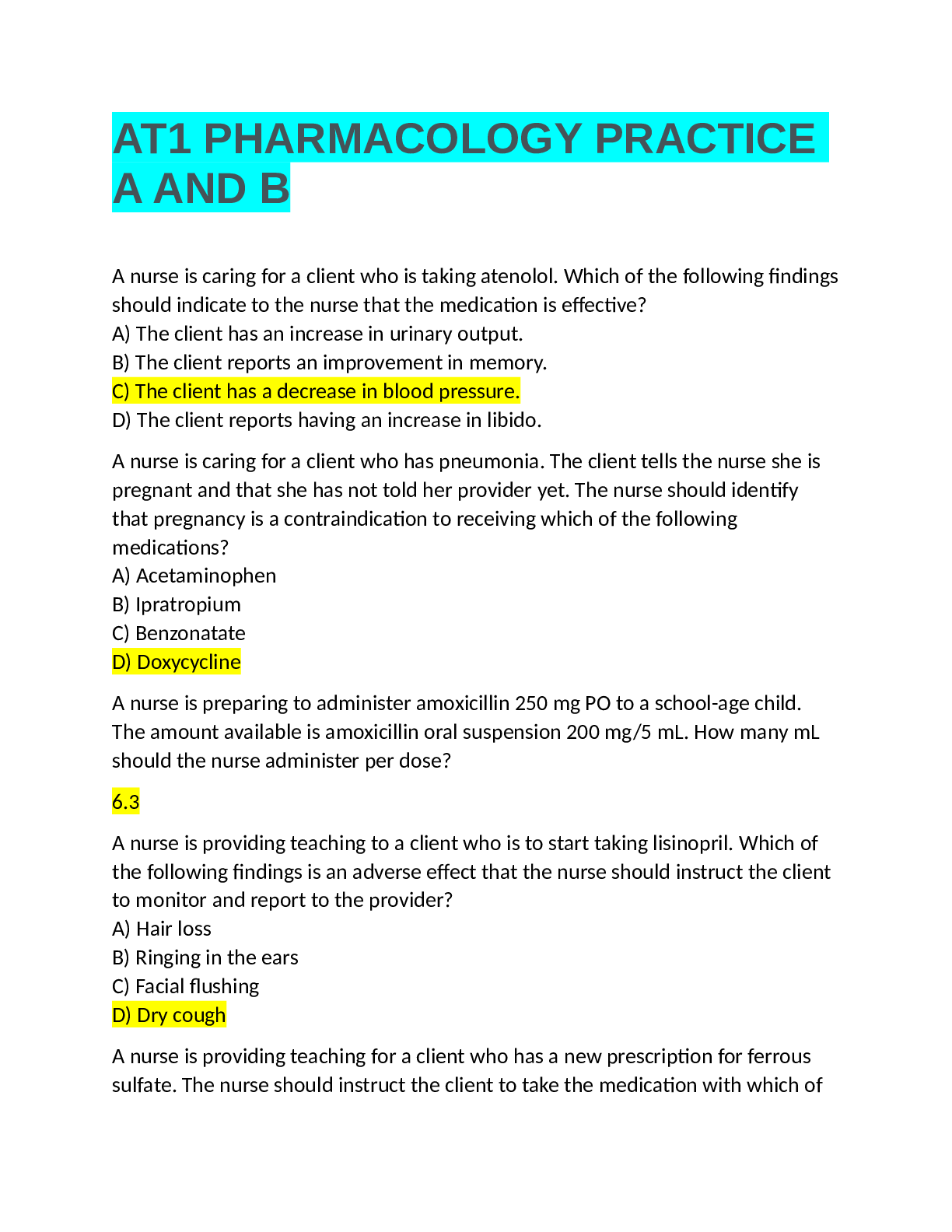
.png)
.png)


 (1).png)

